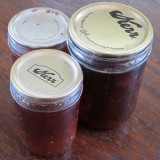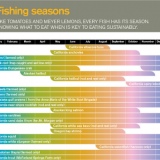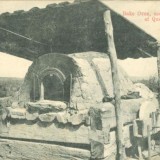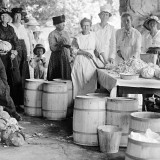I’m honored to have been included in this year’s class of the Los Angeles Master Food Preservers, a program offered by our local extension service to train volunteers to teach food preservation in under-served communities. I thought I would share the textbook resources from the class as they are an excellent set of reference books for your homesteading library. And many are available for free online. Like all information from the extension service system, they are research based.
First off is So Easy to Preserve a large collection of recipes, everything from canning to dehydrating, all carefully tested and in line with current U.S. Department of Agriculture food safety recommendations. The book is put out by the University of Georgia’s Cooperative Extension.
We also will be using the Complete Guide to Home Canning, put out by the USDA and available for free online. Lastly, there’s the classic Ball Blue Book Guide to Preserving, a reliable introduction to the subject.
In addition to covering food safety issues, I like these carefully researched food preservation guides for their reliability. If I’m going to commit the time to doing a food preservation project I like a reasonable chance of success. While we learn from our mistakes, I’d prefer to have a few more jellies and a few less accidental “syrups”.
You can connect with the Los Angeles Master Food Preservers on Facebook and via their blog.





I have a few books on canning, but most seem to only have a very small section on pressure canning. I have a pressure canner and would like to use it more often, for recipes that don’t have all the acid required for water bath canning – do you know of any good resources for pressure canning?
While I realize all the government recommendations and “Ball Blue Book” standards were put in place for valid reasons of safety issues, it irks me that these resources are mostly about high-heat (and thus high-energy inputs) preserving, and mostly sugar based. Neither of which fit with an energy-lean future nor the health need of many Americans to reduce sugar. And that high-heat, high-sugar is what our extension services are proposing to teach to “underserved communities.”
Preserving Food without Freezing or Canning: Traditional Techniques Using Salt, Oil, Sugar, Alcohol, Vinegar, Drying, Cold Storage, and Lactic Fermentation by The Gardeners and Farmers of Centre Terre Vivante (Apr 4, 2007) is an excellent resource that reminds us that our forefathers used many methods of food preservation, not just energy-intense, sugar-based jams and jellies.
I’m also enjoying My Calabria by Rosetta Costantino. It’s about Southern Italian traditional methods — a food-gardening climate that sounds remarkably like here in So Calif. It includes recipes for sundried tomato paste and sundried zucchini, and fermented mixed vegetables, among other gems.
Seems to me that in summer-dry So Calif we need to think a lot more about sundrying food, perhaps moreso than canning it. I don’t know a good drying cookbook (most I have found are for the high-powered electric dryers, or are so funky as to not meet Mr homegrown’s standard of guaranteed success). Traditional recipes such as those in My Calabria and many ethnic Middle Eastern cookbooks might be our answer. There are probably Mexican and mission-era California recipes to be rediscovered, too.
Another aspect of year-round food supply in So Calif is that our climate doesn’t have a hard freeze. Thus some of the primary reasons our ancestors canned — i.e. to secure year round food supply — become irrelevant here. Instead of the basis of winter survival, canned foods slip to a luxury item about diversity of flavors.
Here in So Cal part of our “food preservation” or “year round food supply” homesteading thought process needs to be making the most of our winter gardens, and maintaining high productivity year round. That’s the concept we have been exploring since 2008 at the community garden in Westchester.
Mr & Mrs Homegrown, since you are in at the “ground floor” of the development of LA Master Food Preservers program, perhaps you can insert some of these climate-appropriate and future-appropriate ideas into their curriculum …
Not to be a grammar or spelling Nazi, but did you mean “under-served” instead of “undeserved” communities? I’m assuming that you did.
Excellent post!
Hey Donna,
Thanks for catching that–probably the most embarrassing typo crime I’ve ever committed on this blog!
And Joanne–all excellent points. I’m not a big fan of jams and jellies, to be honest, and am very much interested in climate appropriate methods. We have a final project in the class and I’ll take your excellent suggestions in mind for what I plan to do. I have a solar dehydrator on the roof of our garage and will fire it up again soon.
I like the Ball book for basics like how to pressure can stock and beans, or how to can whole tomatoes, but their recipes (soups, sauces) are truly awful. They taste like something my mom would have cooked in the 70s.
Thank you Joanne for those book recommendations! This has been on my mind a lot lately. I was trying to find canning recipes that don’t use sugar, store-bought vinegar, store-bought pectin, or bottled lemon juice and coming up completely empty. Even a recipe in one book called “Figs preserved in honey” called for a cup of sugar. Or this strawberry jam recipe that would otherwise meet my requirements except for the sugar: 6 pints of strawberries, 9 cups of sugar, 3/4 cup freshly squeezed lemon juice, seeds reserved. I would be ok with honey because my sugar objection isn’t a dietery one; it’s that I can keep bees much more easily than grow sugar cane. I was also coming away from book after book on canning with the impression that, beyond tomatoes, canning must never have really fed anyone, unless there is some culinary period in our history where we ate a LOT of jam, pickles, and chutney. :p Like the first comment posted, I concluded that if you want to can anything that you might actually use, a pressure canner is required (I’m sorry I don’t have a title to recommend there).
I’ve been meaning to join them! but I keep collecting degrees…. i should just stop and start joining fun groups like these.
Hey Joanne– I agree with you about the sugar! And most of the recipes are bad.
Also, we have another book by the folks at Terre Vivante, called Keeping Foods Fresh. Maybe it’s the same book? Ours was a wonderful window into old preservation methods, and some we’ve tried. Others are a teeny bit scary–like I remember one where tomato sauce was left out for a time to ferment, then decanted into old wine bottles, capped with wax and stored. It’s probably delicious, and probably folks have been using this sauce for generations….but!!!
I dunno. Mostly I just wish I had a root cellar and then everything would be so much easier. I’d store veggies whole and do lots of ferments and skip canning for the most part.
I tend to be a lot more laid back about food safety issues than Erik. Now that he’s taking this class, that gulf could get a lot wider! We’ll see if he drinks the KoolAid.:)
To all the active and engaged, wonderful people commenting here: first, our lead instructor, Chef Ernest Miller always says Pressure canning is the most important form of food preservation. If you reach out to him, he might even send you his wonderful introductory booklet, Pressure Canning 101. And, just to remind everyone, fermentation,pickling, freezing, charcuterie, dehydration are also methods of preservation that often require little or no use of sugar. As University of California Cooperative Extension representatives, the LA County Master Food Preservers are food safety advisors who use USDA recommendations as a guide. There are lower sugar options that USDA backs up with research if jams and jellies are your focus.
For low-sweetener jams and jellies, try Pomona’s Universal Pectin. It is different from regular pectin because it contains no sugar or preservatives and jells with low amounts of any sweetener. You only cook the fruit for a few minutes or you can make freezer jam with raw fruit, although some fruits are better than others as freezer jam. Pomona’s jells in the presence of calcium, which comes in the box with the pectin. It is available in natural food stores, like Whole Foods, and food co-ops all over the country. It is also available on our website: http://www.pomonapectin.com. Yes, I work with my sister to sell Pomona’s. We are a very small company and would like to have more contact with the Extension Services and Master Food Preservers around the country.